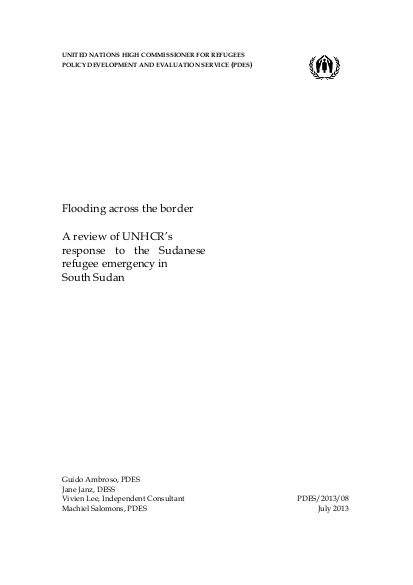
A real-time review of UNHCR’s response to the Sudanese refugee emergency in South Sudan was conducted from 4-14 December 2012. The mission noted a challenging context where planning efforts and emergency responses were adversely affected by geographical and climatological conditions. Moreover, a number of institutional, bureaucratic and operational impediments further reduced the pace at which UNHCR was able to respond to the unfolding crisis, resulting in an initially insufficient scale-up to respond to the emergency. The mission found that one of the main challenges faced by UNHCR in its response to the emerging crisis was the timely dispatch of sufficient numbers of qualified and experienced technical staff. Key interviewees suggested that UNHCR had been keen to show it could assume its responsibilities in the face of the emergency, in spite of the fact that it only had limited available institutional and financial support. A compounding factor adversely affecting the early emergency response by UNHCR were the countless competing crises taking place in the newly established Republic of South Sudan. According to many NGOs on the ground, UNHCR’s coordination performance dramatically improved over time and took on a more inclusive and transparent approach. Eventually, all acknowledged that UNHCR had played a lead role in the assistance and protection of refugees. Whilst delays were recorded in identifying alternative non-flood prone sites in Upper Nile and Unity States, and also in view of the very limited options available, it must be acknowledged that the Representation of South Sudan consistently followed UNHCR’s official guidelines on the distance of refugee camps in relation to international borders. Various constraints meant that the identification of alternative sites were delayed but ultimately the objective of identifying non-flood prone sites – in line with UNHCR guidelines – was achieved, in spite of challenging conditions and criticism by NGO partners on the ground over delays. The continuing political and military crisis in Sudan is likely to lead to a long-term refugee presence in South Sudan. This development underscores the importance of adopting a two-pronged strategy containing the following elements: 1) Ensure the continued preparedness for a renewed influx, including finding appropriate sites, prepositioning relief items, improving logistics and having sufficient technical capacity in place. 2) Facilitate the consolidation phase aimed at improving conditions of the existing refugee population and of host communities, including livelihoods, self-reliance, reforestation and community-based quick-impact projects.